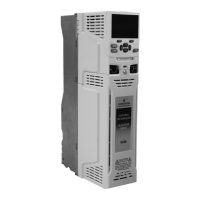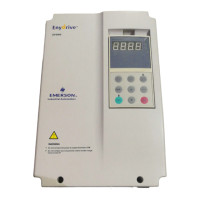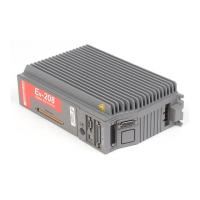Safety
information
Product
information
Mechanical
installation
Electrical
installation
Getting
started
User Menu A Commissioning
Advanced
Parameters
Diagnostics Optimization CT MODBUS RTU Technical Data
E300 Design Guide 451
Issue Number: 1
Motor acoustic noise
on drive enable, motor
operation
Incorrect drive switching
frequency selected
Note the drive will modulate between a minimum (B14) and a maximum (B13) switching
frequency. An increase in the drive maximum switching frequency may result in an
output derating.
• Adjust the drive switching frequency in parameter B13 and B14.
Current control loop
The current control loop gains calculated from the autotune may be high for the given
motor and can therefore be manually adjusted or a current control loop filter
implemented. Note there is separate current control adjustment for (1) Start and (2)
Travel-Stop as default.
• Refer to Menu I Tuning to adjust the current control loop under both full load and no
load conditions.
Speed control loop
The speed control loop gains may need to be tuned for the given system. If the acoustic
noise is during standstill adjust Integral speed loop gain, if the noise is during operation
reduce the Proportional speed loop gain. Note there is separate speed control loop
gains for (1) Start, (2)Travel, Stop as default.
• Refer to Menu I Tuning to adjust the speed control loop under both full load and no
load conditions.
• Ensure good EMC practices are followed for the position feedback, induced noise
can limit the level of control loop gain which can be achieved
Wiring issue, induced noise on
position feedback
If there is induced noise on the position feedback from the motor to the drive due to the
wiring arrangement, screening and terminations this will result in unstable operation
and acoustic noise from the motor.
• Ensure good EMC practices are followed, if issue persists a position feedback filter
can be implemented with Drive Encoder Feedback Filter (C09)
Elevator system mechanical
issue
Check during operation that any acoustic noise present is not being generated as a
result of a mechanical fault with the Elevator system or is a fault with motor, gearbox
and/or couplings
Reported fault Root cause Recommended actions
Elevator incorrect
operating speed or
direction
Elevator mechanical data not
entered correctly
In order for correct operation at the systems rated speed, the mechanical data for the
Elevator system must be entered correctly, this includes the Nominal speed (m/s)
Sheave diameter, Roping, Gear ratio and Maximum speed.
• Refer to Menu E Mechanical to enter the mechanical data
Elevator operating speeds not
set-up
The E300 Advanced Elevator drive in default set-up has 4 speed selections V1 through
to V4 which can be adjusted in parameters G01 through to G04. Also ensure that the
correct control connections are made to the drives control terminals to select the
required speed.
• Refer to Menu G Profile to set-up the operating speeds and Menu F Hardware IO
for the control input configuration and monitoring
Incorrect direction input
configuration, selection
Where operation in an incorrect direction is identified, check that the correct direction
input control single or dual directions) has been set-up in Control Input Mode (H11) and
is being selected. Also check that the motor power and encoder connections are of the
correct rotation
• Refer to Menu F Hardware IO for input direction control
Autotune has not been
completed for RFC-S mode
with a PM motor in a gearless
Elevator system
For PM motors and operation in RFC-S an encoder phase angle test must be
completed before operation. Failure to do an autotune will result in a loss of control and
on brake release the motor could move in either direction dependant upon the direction
of the load.
• Refer to Motor Autotune (B11)
Motor power, encoder control
connections
Check both the motor power connections and the encoder control connections for the
correct rotation.
• Refer to Reverse Motor Phase Sequence (B26) for the motor or Drive Encoder
Feedback Reverse (C12).
Reported fault Root cause Recommended actions

